Image by Steve Luzader
The Coathanger asterism between Sagitta and Vulpecula. This
grouping of stars is also known as Collinder 399. If you look
carefully you can see the tiny open cluster NGC6802 as a faint fuzzy
patch just below the last star in the straight part of the hanger at
the bottom center of the image. The image is an average stack of
three 59 second exposures with a 300 mm lens @ f8 attached to a Canon 60Da camera set for ISO 1600.
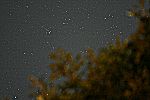
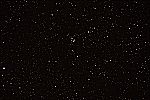 Images by Steve Luzader
Images by Steve Luzader
These images of NGC457 in Cassiopeia, AKA the Owl Cluster or the
ET cluster. These images show the cluster in its stellar context in
contrast with the extreme closeup below. The left image was
taken on Aug. 30, 2012, and
shows ET rising from the trees behind my house in Frostburg. The moon
was quite bright that night. The right image was taken with on Sept. 13, 2012, with no moon present. Both pictures were taken with a 300 mm Rokunar lens @ f8
fitted to a Canon 60Da set for ISO 1600. The Aug. 30 image is a
single 15 second exposure, and the Sept. 7 image is an average stack of
two 30-second exposures.
 Image by Steve Luzader
Image by Steve Luzader
NGC457 in Cassiopeia. Affectionately known as "ET", this open cluster
has become a favorite at the public observing sessions in the Glendening Recreation
Complex. This is a mosaic of nine 10 second STV images taken with my 8-inch
STV at f/6.3. In this image, ET is almost on his head with his eyes
at the left side and his body extending toward the upper right.
 Photo by Rob Himmler
Photo by Rob Himmler
NGC 7000, the North America Nebula in Cygnus. The exposure was 40 minutes on Ektachrome
200 slide film using a 120 mm refractor at f/4 .
 Photo
by Steve Luzader
Photo
by Steve Luzader
The nebula NGC2024, the Flame Nebula, in Orion. The exposure was 20 minutes
at prime focus of my 8-inch SCT at f/6.3 on Kodak MAX 400 color negative film.
The telescope was being guided by my STV image. The bright star is Alnitak.
 Photo
by Steve Luzader
Photo
by Steve Luzader
The open cluster NGC6940 in Cygnus. The exposure was 20 minutes at prime focus
of my 8-inch SCT at f/10 on Fuji Superia 400 color negative film. The telescope
was being guided by my STV imager.
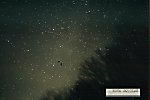 Photos by Gus Johnson
Photos by Gus Johnson A nova erupted in the constellation Acquila late in 1999. Clicking on the thumbnail will bring up a pair of images. The top photo was taken on Sept. 24, 1989, while the bottom image was taken on Dec. 8, 1999. The nova is seen just below the center of the bottom image. Its magnitude at that time was about 5.2, down from a peak of mag. 4 on Dec. 2. The top exposure was 4 - 5 minutes on ASA 1600 negative film, and the bottom exposure was 3 minutes on Kodak ASA 400 negative film. Both shots were taken with a 50 mm lens at f/1.9. An equatorial mount was used for the 1989 photo, while altazimuth tracking was used for the nova image.
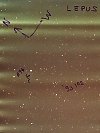 Photo by Gus Johnson
Photo by Gus Johnson
This is one of a group of interesting asterisms that Gus Johnson has been cataloging. This one, located in Lepus, is designated GJ102 and was photographed in response to a Sky & Telescope article on equilateral triangles. The exposure was 2.5 minutes on Kodak ASA1000 film using a 250 mm lens at f/4.5. A hand-guided equatorial mount was used. The film did not wrap properly on the takeup spool and was damaged in the camera.
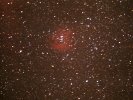 Photo by Gus Johnson
Photo by Gus Johnson
A photograph of the Rosette Nebula. A 250 mm lens at f/4.5 was used for this 2 minute exposure on Kodak ASA1000 negative film. The camera was on a hand-guided equatorial mount.
 Photo by Steve Luzader
Photo by Steve LuzaderMizar in the handle of the Big Dipper. This prime focus photo was taken with my 8" Celestron SCT at f/10 using a piggyback telescope for correction to the Celestron's own clock drive. The exposure was about 30 seconds on Fujichrome Sensia 100 slide film. The double star Mizar (magnitude 2.4) and SAO28738 (magnitude 4.0) aren't quite separated in the lower left of the image. The bright star at the upper right is Alcor (magnitude 4.0), and the faint star in the upper left is SAO28748 (magnitude 8.8).
 Photo by Gus Johnson
Photo by Gus Johnson
Milky Way star fields in S. Aquila and Scutum. The exposure was 4 minutes on Fujicolor 1600
negative film with a 50 mm lens at f/1.9. Equatorial tracking was used.
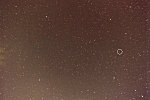 Photo by Steve Luzader
Photo by Steve LuzaderThe region inside and around the great square of Pegasus looks rather empty to the naked eye, but many stars are visible in this piggyback photo. The circle marks 51 Pegasi, which was the first star with an orbiting giant planet to be detected from earth. The exposure was 15 minutes on Fujicolor 200 negative film with a 55 mm lens set at f/2.
 Photo by Gus Johnson
Photo by Gus Johnson
A photograph of Jupiter near Sagittarius taken in August 1984 rural western Maryland. The
"teapot" of Sagittarius can be seen in the left center of the picture, with bright Jupiter
just above the spout. The Lagoon Nebula (M8) is visible just to the right and below Jupiter.
The open clusters M6 and M7 are the fuzzy patches to the right of the spout of the teapot.
The exposure was 5.5 minutes with a 50 mm lens at f/3.5 on ASA 1000 color negative film.
Hand tracking was used to guide the camera.
 Photo by Steve Luzader
Photo by Steve Luzader
A photograph of the Milky Way in Sagittarius taken in September 1995 near Keyser in rural West Virginia. The
"teapot" of Sagittarius can be seen in the lower center of the picture. M8, the Lagoon Nebula,
is the pinkish patch just about the spout of the teapot, and M6 is the fuzzy patch near the
lower right corner of the image. This piggyback exposure was for 20 minutes with a 55 mm lens
at f/4 on Fujichrome Sensia 100 slide film. The camera was riding on my Celestron 8" SCT.
Before taking the picture, the telescope was centered on M22, which remained centered in the
eyepiece during the entire exposure with no hand correction to the telescope's own tracking.
 Photo by Gus Johnson
Photo by Gus Johnson
The region of Cygnus around the "Northern Cross". Deneb is the bright star at the upper
center of the photo. The North America Nebula (NGC7000) is visible to the left of Deneb.
A closer view of the supernova remnant near Sadr is presented in another photo. This piggyback
picture was taken with a 50 mm lens at f/1.9 on ASA 1600 Fujicolor film. The exposure was 3
minutes with hand guiding. A satellite crossed the guiding ocular during the exposure.
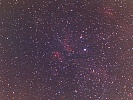 Photo by Steve Luzader
Photo by Steve Luzader
This photo shows a supernova remnant near the star Gamma Cygnus ("Sadr") in the Northern
Cross. Sadr is the bright star just to the right of center in the picture. This was a
20 minute piggyback exposure on Kodak Gold 800 film using a 300 mm lens at f/5.6. The
red color of the hydrogen gas in the nebula was enhanced during image processing.
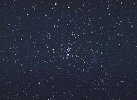 Photo by Rob Himmler
Photo by Rob Himmler
The region of the double cluster in Perseus cluster. The photo is a piggyback shot using a
35mm lens at f/2.6. The 25 minute exposure was made on Kodachrome Elite 200 ASA slide film.
The famous double cluster is visible near the center of the image, which was scanned from
the slide.
 Photo by Steve Luzader
Photo by Steve LuzaderNGC869 and NGC884 (the Double Cluster in Perseus) as seen from my driveway. (869 is the top cluster.) The exposure was 20 minutes on Fujicolor 200 film. The picture was taken with the 80 mm f/5 Orion "ShortTube" refractor riding piggyback on a Celestron 8" SCT. This has been one of my favorite viewing objects since I "discovered" with an old Criterion 6" reflector a few years ago.
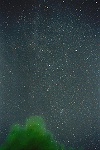 Photo by Steve Luzader
Photo by Steve LuzaderThis piggyback photo of Cassiopeia shows a large number of open clusters, which appear as small fuzzy blobs in the image. The exposure was 20 minutes with a 55 mm lens at f/2 on Fujicolor 200 film. Click here for a version of the image with several of the clusters circled and named.
 Photo by Gus Johnson
Photo by Gus Johnson
The region of the a Persei cluster. NGC1245 is visible as a fuzzy patch to the right of
a Persei. The hand-guided piggyback exposure was about 4 minutes on ASA 400 film with a
135 mm lens at f/2.8.
 Photo by Gus Johnson
Photo by Gus Johnson
A photo of the Hyades taken on ASA 1600 Fuji film. NGC1662 is barely visible near the
lower left corner. The exposure was between 2.5 and 3 minutes with a 135 mm lens at f/2.8.
The telescope was guided by hand for this picture.
 Photo by Gus Johnson
Photo by Gus JohnsonNGC6231 in Scorpius. The exposure was 3 minutes on ISO400 film using a 250 mm lens at f/4.5 with altazimuth tracking.